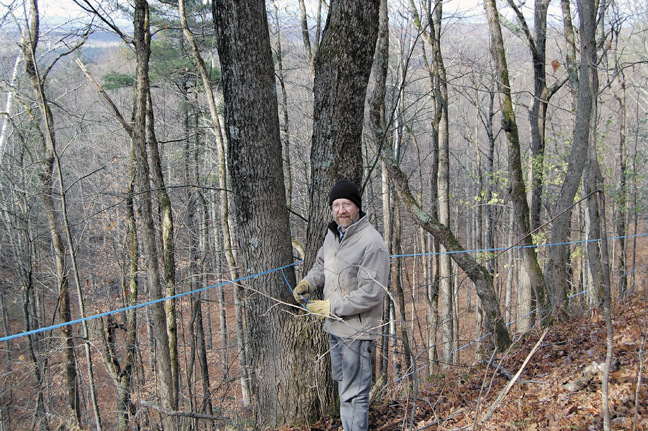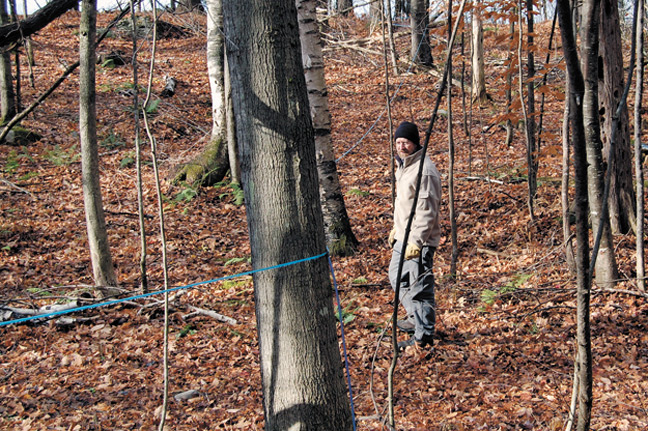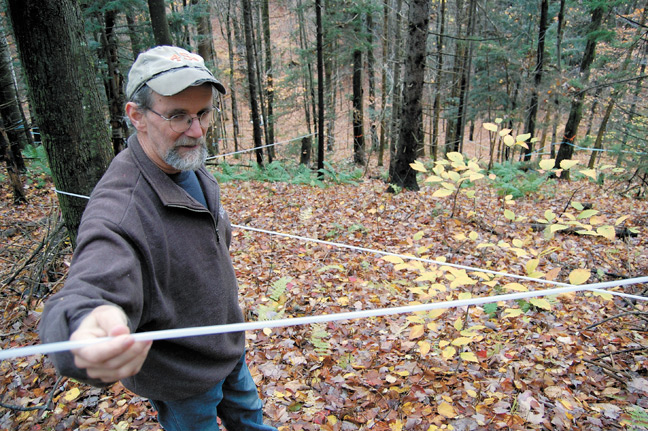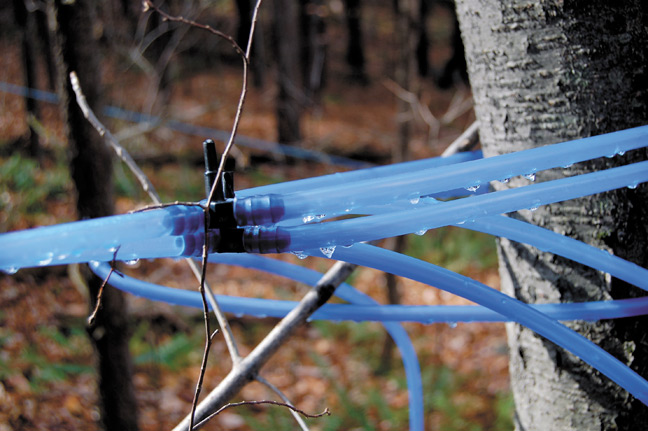UVM Proctor Page
The 3/16 phenomenon
Using 3/16” tubing: principles and practices
By TIM WILMOT |
Gravity tubing systems typically do not perform well compared to systems connected to modern vacuum pumps; however, there are new options today for creating high vacuum in gravity tubing. As many people know, a system using tubing with an interior diameter of 3/16” has been developed in recent years at the University of Vermont Proctor Maple Research Center and has shown considerable success in a variety of locations. Because I have been experimenting with this tubing over the past 5 years, I thought it would be helpful to review the primary findings from this research, to explain some of the principles of achieving high vacuum and high sap yields on sloped sites, and also to share the most recent research that demonstrates applications for this tubing when used in a pumped vacuum system.
Natural Vacuum Principles
Natural vacuum is created in a tubing system when a quantity of sap in the tube pulls on a taphole. If the taphole is tightly connected to a spout and tubing, external air cannot enter the tube and the weight of the sap draws a vacuum on the enclosed space within the tubing. More weight equals more vacuum, up to a point that is the physical maximum for vacuum (around 29.9” Hg at sea level). The weight of the sap is determined by the elevation from the top to the bottom (bottom = the outlet to the atmosphere) of the sap column in the tubing—so if the tubing runs down a slope that is 20’ from top to bottom, and the tube is full of sap, the weight of the 20’ of sap is theoretically enough to create 17.7” Hg (mercury vacuum) above the liquid. The physical formula 1’ water or sap = 0.88” Hg, or 1.14’ of water = 1” of Hg, allows a sugarmaker to determine the maximum possible vacuum that can be achieved in gravity tubing. It is important to realize that this is the amount of vacuum achievable for a taphole that is at or above the height just described. When the taphole is lower than this, for example when the taphole in question is in the middle of the line and is only 10’ in elevation from the bottom, then the maximum vacuum at that taphole will be less—10’ of sap will pull a maximum possible vacuum on that taphole of about 8.8” Hg. It is also important to realize that making the line longer, without changing the total drop in elevation from the top to the outlet, will not increase the vacuum, because it will not increase the weight of the sap.
With an interior diameter much smaller than standard tubing, a foot of 3/16” tubing will hold only 36% as much sap as a foot of 5/16” tubing, so a given quantity of sap extends much farther along the smaller diameter tubing. This is the reason why higher vacuum can be created in the smaller tubing—on a slope, the longer length of sap in the tubing will extend over a greater elevation change, and thus exert more weight on the taphole. Additionally, in a 3/16” or smaller tube, atmospheric pressure on the open lower end of the tube keeps the liquid suspended, and the tube is small enough that the liquid’s surface tension mostly blocks the entry of air. Other forces, particularly adhesion to the tubing wall, may have a slight effect in holding the sap in place. While the presence of enough sap in a 5/16” line can also generate vacuum, even very high vacuum under the right conditions, in a comparison of gravity sap lines a 3/16” line should almost always outperform a 5/16” line. This holds true unless unusual problems occur or mistakes are made in setting up the system, which are discussed further below.
Vacuum
Vacuum is critical for good sap yield, and our research has shown that each additional inch of vacuum usually provides 4-6% more sap. A vacuum gauge installed at the top-most tree should indicate the maximum vacuum that any of the tapholes on the line are exposed to. Vacuum in a leak-free line of 3/16” tubing that descends far enough to its outlet should be around 27” Hg. Most vacuum gauges that sugarmakers will use in the woods are inexpensive and accurate to only plus or minus 1-2 inches Hg, so variation in this reading may be due to the gauge. Additionally, although the gauge should be attached to a dropline that provides something of a buffer from sap contamination, freezing and thawing sap entering the gauge may eventually damage it, causing erroneous readings. This is much more common with a gauge installed mid-line.
Multiple weeks, and in some cases years of measurements on lines on different slopes with 4-37 taps, and lengths from 100’-700’ have generated the following estimates of expected vacuum: assuming no leaks, vacuum at the top of line in inches will be approximately 50-75% of the vertical drop in feet. Thus, for a vertical drop of 24’, a vacuum level of 12-18” can be expected; for a vertical drop of 40’, 20-27” can be expected, and for a vertical drop of 55’ and more, the vacuum at the upper most taphole should be 27” or more. These vacuum readings should be present at almost all times when the sap is running. While these levels of vacuum are not the theoretical maximum possible with a line that is completely full, they reflect the fact that lines are rarely completely full, as gas is continually emitted naturally from the taphole, and that even the tightest system may allow very small amounts of outside air to enter.
Below the uppermost taphole, the vacuum should be the same or less than the amounts just described. Although the sap in a 3/16” gravity line can be observed moving rapidly past a T fitting that is located lower down on a line, and one engineer has calculated that there is a slight Bernoulli affect at the T, there is no evidence that this boosts vacuum at the lower tapholes. The vacuum at any particular taphole is best estimated by the remaining drop from that location to the bottom of the line. Repeated measurements at the PMRC have confirmed this. For this reason, it is important to have as much vertical drop as possible below any of the trees on the line. This may not be possible, given the lay of the land, in which case producers should be aware that tapholes nearer the bottom of the line will be exposed to less vacuum as the vertical drop decreases.
Leaks
Although leaks in a gravity line affect only that line, they can have far more impact on vacuum than they would in a pumped line, because the leak can remove the entire source of vacuum—the suspended sap. When air through a leak enters the top of the tube, the atmospheric pressure holding the sap in place is equalized, causing the sap to drain quickly, and the vacuum from the suspended column of sap disappears. Some leaks are larger than others, and a tiny leak may allow only enough air entry to degrade but not eliminate the vacuum. A leak the size of a small hole will generally mean the total loss of vacuum below it. If the leak is at the top of the line, for example a loose vacuum gauge, a squirrel chew etc. the vacuum in the entire line will be absent. If the leak is further down the line, the leak will likely cause the loss of all vacuum at tapholes below it, but the vacuum at the top of the line will correspond to the elevation from the top of the line to the leak, so it won’t disappear entirely.
Sap Flow
In many studies that involved sap collection for an entire season, sap yield with 3/16” tubing was commensurate with vacuum—i.e. high vacuum has led to high sap yields. There was no indication that sap flow was limited by a large number of taps on these small lines, although improper setup, or a vast number of taps could probably make that occur. Sap generally moves rapidly down a 3/16” tube, as the high vacuum causes a constant addition of liquid to a small space which pushes out the suspended sap. Sap flow rates faster than 5 ¾ gallons per hour on a line with 22 taps (in 2011) have been observed in the field, and this has probably been exceeded in other years. In a 2013 test of whether sap yield (gallons/tap) was less in a 700’ line with 37 taps compared to 6 short lines with a total of 37 taps, on similar slopes, there was virtually no reduction in the line with many taps—both lines produced sap yields in excess of 36 gallons/tap that year. Many other tests have resulted in sap yields that are as good as those produced under high vacuum with the UVM PMRC pumped system. Many other producers using 3/16” gravity tubing have also reported high sap yields.
What Could Go Wrong?
Over the course of many experiments with 3/16” gravity tubing, a variety of possible problems and mistakes have been observed that could make the use of this system less than satisfying. Most, if not all, can be avoided. I have once seen last year’s slime block a 3/16” T, and this could be a more common problem if sap is allowed to remain in sags in the tubing over the summer. To avoid sags, this smaller diameter tubing needs somewhat more support than 5/16” tubing, and producers who don’t clean their tubing at the end of the season should try to drain sap standing in sags. Leaks, as described above, can eliminate all vacuum, and unless producers are actively repairing leaks during sugaring, then they are advised to limit the number of taps on each line, so that a leak on any line won’t affect a great number of taps. Too many taps might overwhelm a line, although the number that is “too many” is unknown; and too few might not provide enough weight in a line, although 200’ lines with 4 taps on a slope have worked very well in my research. Some novel arrangements of this tubing have proved unsuccessful, for example, 5/16” tubing used as a “mainline” for multiple 3/16” tubing lines has been reported to be a failure, as this causes flow restrictions. Another possible source of restriction is branching 3/16” lines into each other—this may work with a branch carrying 1 to 2 taps, but not more. Trying to siphon sap over a hill by placing all the taps on the backside and a long stretch of tubing down a slope beyond this has not worked for me. I’m sure there are other possible experiments that could cause a producer to become very frustrated with 3/16” tubing; however, straightforward setups as described in a previous article, http://www.uvm.edu/~pmrc/highvacuum.pdf, have worked very well over many years, and are made even easier now with the availability of tubing and fittings manufactured specifically for 3/16” maple sap systems.
Pumps and 3/16” Tubing
A number of producers are currently experimenting with a “hybrid” system that uses both natural vacuum from 3/16” tubing and vacuum from a pump. In 2014 I demonstrated one possible application of a hybrid system by running 3/16” lines down a shallow slope and connecting them to a mainline serviced by a small diaphragm pump. In this experiment the mainline vacuum averaged 21” Hg when sap from 100 taps went through the pump. Several of the lines running into the mainline were 125’ long or less. On average, these lines had 4.3 taps, dropped 13’ in elevation from the topmost taphole to the mainline, and gained 4.6” of vacuum at the top of the line. Several other producers, some using much more powerful pumps, have reported similar results. New experiments at the PMRC using 3/16” tubing in conjunction with a Busch pump are planned for 2015. Some producers are currently testing whether 3/16” tubing is more effective in moving sap uphill over a road crossing, or in pulling sap up from taps below the lateral line. Sharing the results of these tests can benefit all producers, as we learn more about possible ways to take advantage of these new systems. Producers with results, both good and bad, from the use of 3/16” tubing are urged to contact me at timothy.wilmot@uvm.edu.
This research was partially funded by a grant from the North American Maple Syrup Council.
December 2014


































